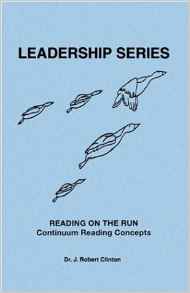|
|
READING ON THE RUN Continuum Reading Concepts which Help the Busy Leader Read Selectively to Acquire Information Dr. J. Robert Clinton Self-Published, 1987, 52 pp. (held by Mashburn Memorial Library, AZUSA Pacific
University, Azusa, CA 91702) |
|
Clinton, professor of leadership
at Fuller School of World Mission, was introduced to in-depth reading through
Mortimer J. Adler’s book, How to Read a Book. Alternatively, he felt the need to develop
approaches to obtain information from books by less intense study. This book looks like it could be a course
outline. Reading for pleasure requires
word-by-word reading. “To obtain
useful information does not require that one get lost in word by word reading
or constructing lists of information to be repeated. Instead, reading for information requires
the ability to overview, extrapolate, draw implications, move rapidly through
material looking for selected ideas, etc.
In short, the purpose of reading should control the reading
methodology.” “You have read a book
using continuum reading concepts when you have assessed the level it should
be read at and you read only as much as necessary at that level to obtain
useful information from the book.”
(45) The reading continuum: (5) 1.
Scan – overview of contents 2.
Ransack – new ideas, specific ideas 3.
Browse – some in-depth contextual analysis 4.
Pre-Read – determine thematic intent, structural
intent 5.
In-Depth Read – analysis of thematic content,
evaluation analysis 6.
Study – repeated work in the book, comparative
analysis Each level assumes the book has
been read at the previous level. Scan reading involves a review
of the contents, introductory information, dust cover, information on the
author, and thumbing through the book to note any conclusions, summaries,
charts, quotes, illustrations, etc., to get a cursory understanding of what
the book is about and how it is organized. (7) After scan reading one might
make notes on the author, the author’s perspective, the book’s organization,
the author’s intent, and an assessment of the value of further reading. (10) “Closed scanning refers to
reading while looking only for a pre-selected topic of interest. Open scanning refers to reading while
looking for new ideas.” (13) After ransack reading one might
make notes on new ideas of helpful information, a contrasting or differing
idea on the pre-selected topic, something of interest on some other topic,
and evaluation of the value of further reading. (18) “Browse reading is dipping into
certain portions of a book to study in detail some discussion of a topic in
its contextual treatment.” “Frequently I will browse the preface and
introduction of a book then browse the conclusion of it and do whatever other
browsing or ransacking needed to fit the conclusions into the overall context
of the book.” (20) Pre-reading should produce ·
A statement describing the kind of book ·
A statement giving the author’s intent and
methodology. ·
A statement identifying the major subject and how
it weaves together the major ideas ·
Statements indicating the intent of each major
section and its contribution ·
An evaluation of miscellaneous helps available (29) In-depth reading should produce
six evaluation statements: 1.
Show where the author is uninformed (giving
examples) 2.
Show where the author is misinformed (giving
examples) 3.
Show where the author is illogical (giving
examples) 4.
Show where the author’s analysis is incomplete
(giving examples) 5.
Show the author’s strengths 6.
Show the relevance of the book to today’s needs
(33) You should be able to persuade a
potential reader as the value or lack of value in reading it. (36) “Studying a book is a special
in-depth approach to the reading of a book which involves pre-reading,
reading, and background research on materials and ideas used in the book.”
This kind of reading is usually limited to ·
“Essential works which will significantly affect
your ministry (basal books in your field). ·
Works which are complex in concepts and/or
structure and which usually require more than several read-throughs.”
(40) A basal book is one that covers
a category thoroughly from a theoretical perspective and serves as a standard
for comparing other books. (41) “Effective leaders maintain a
learning posture throughout their lives.” (45) “Frequently, God significantly
affects a leader through some interaction with written ideas.” (45) |
|
